Susan Smith-Josephy's Blog
July 27, 2020
New blog post: newspaper coverage for Cataline book
I really appreciated being interviewed the Quesnel Cariboo Observer Lindsay Chung earlier this year. Lindsay is away from her editor’s post for a while.
A quote from the 22 July 2020 issue of the Quesnel Cariboo Observer issue says, “At the start of the pandemic, Cariboo Observer editor Lindsay Chung — also a Canadian Ranger — was summoned for active duty. Chung answered that call for assistance from the Canadian Rangers but is expected to be back at her editor’s chair in September.” I knew Lindsay was an impressive young woman, she was a great interviewer.
To read Lindsay’s original article, click here.
I was also really honoured to have my book reviewed in the Vancouver Sun, and apparently, the review got syndicated to a lot of other newspapers as well. Tom Sandborn, the author of the review, said: “Cataline would be an ideal protagonist for an adventure movie. His long hair and beard, the Mexican throwing knife tucked into his boot, his broken English, and his extraordinary skill at training and using pack animals over rugged terrain all made him a colourful and memorable figure.”
To read the whole review, click here. I’d only read the review online so I was very pleased when someone (OK, it was my mom) gave me an actual physical newspaper with the review. Here I am (below), proudly holding up a copy of the review. For an author, a review means so much! So if you want to help out any author, leave a review on your own blog, or on Amazon or on Goodreads. It costs nothing and means the world to people who write books. I have to say that the review on my Amazon page is unusual, but appreciated nevertheless!
[image error]Book review: Packer Cataline a strong and reliable B.C. pioneer. Reviewed in The Vancouver Sun, July 3, 2020. Review by Tom Sandborn.
July 19, 2020
New Blog Post: radio interview on CBC’s Daybreak North
If you’re up and about on Monday July 20, I will be on CBC’s Daybreak North at 8:15 am discussing the book ‘Cataline: The Life of BC’s Legendary Packer’. I’m looking forward to my interview with Wil Fundal so tune in to 91.5 FM.
Edit UPDATE, July 20: Here’s a link to the interview in case you missed it:
I was on @daybreaknorth this morning to talk about the life of famous mule train packer, CATALINE https://cbc.ca/listen/live-radio/1-109/clip/15787990… (starts at 51:45)
[image error]
July 17, 2020
New blog post: BC Bestseller List
I was so happy to see that the book “Cataline: The Life of BC’s Legendary Packer” debuted on the May 16 BC Bestseller List.
To be in such company as Robert Budd, Roy Henry Vickers, Richard Wagamese, Ken Mather and many more, is a true honour.
Now, nine weeks later, the book is still on the list and has fluctuated up and down, currently at #5.
[image error]
The BC Bestseller list is compiled by Read Local BC, “which is a project from the Association of Book Publishers of BC that celebrates the vibrant community of authors, publishers, bookstores, and libraries that make up our province’s literary landscape.”
Thank you to everyone who purchased this book, thank you also to the booksellers and to Caitlin Press staff who have done such a great job of promotion, as well.
July 13, 2020
New blog post: My Writing Day
Writers often get asked about their writing routines and schedules. I do only have one steadfast rule, and that is to write something every day.
That being said, when writer and editor Rob McLennan asked me a few months ago to be a part of his ‘my (smallpress) writingday’ blog I was happy to contribute and participate.
[image error]My desk. Note the whiteboard calendar, which I stopped writing on in March 2020. I haven’t scheduled anything since then! The handsome gentleman in the front of the calendar is my grandad, Thomas Farrow Smith. The dog is Penny. Yes, that is snow outside.
If you know a writer who would like to submit his/her/their “writing day” description, contact Rob at rob_mclennan@hotmail.com
To check out my submission, click here.
One thing I’ve changed about my writing day is the introduction of an ongoing notebook of things I’ve done and stuff I have to do. One the left-hand side of the page I write the date and everything I did that day for my writing, whether it be contacting someone, researching a topic, transcribing notes, ordering books, reading on my subject, editing something, or working on book promotion. Everything gets written down because it helps me keep track of my activities and, if I have a slow day (I have many!), I can flip back and look at what I’ve done. It encourages me and keeps me motivated. Plus, it generates new ideas.
Then, on the right-hand side of the page I have a To Do list, and I add to it whenever something comes up. And when I finish a task, I cross it out and write DONE. Very satisfying.
I’m not the most organized person, so I have to find ways that work for me. Researching and writing a book isn’t done just by one person, it takes a team of people. Granted, the author is the one coordinating everything, and, initially spending time and money getting the project off the ground. So, with all the different aspects that need to be wrangled, I find that keeping a record of my activities in the notebook really helps.
July 6, 2020
New Blog Post: Cataline’s Last Days
Jean ‘Cataline’ Caux lived a full and varied life in the new province of British Columbia. After running pack trains up and down the province for more than 50 years, Cataline retired to Hazelton to live out his days.
He had many friends there, and they looked after him. These were the days before pensions and universal health care. However, Cataline was lucky to be in Hazelton because there was a subscription service (a form of health insurance) to the Hazelton Hospital.
[image error]
A new book, ‘Service on the Skeena: Horace Wrinch, Frontier Physician’ by Geoff Mynett mentions Cataline (page 250):
“The old packer Cataline died in 1922. He had always said that he did not like hospitals and that people only went there to die. Despite such talk, though, he had in fact contributed to the hospital’s appeals for donations over the years. He had resisted going there for as long as he could. His friend Sperry Cline took him eventually, grumbling, and groaning an, and there he did die.”
“They buried him in the cemetery on top of the bluff. Horace and Cataline were hardly friends, but Cataline was a link to the distant pass, to the days when Hazelton was cut off from the outside world for four or five months of the year. H was, moreover, a link to the gold rush days of the middle of the previous century.”
Find A Grave, an online collection of gravesites and cemeteries, has a listing for Cataline. He is buried in Gitanmaax Cemetery in Hazelton, British Columbia.
July 1, 2020
New blog posts: Cataline books in hand!
After looking longingly of pictures of the cover of “Cataline: The Life of BC’s Legendary Packer” online, I was happy to receive a box of my books last month. It’s been really fun to sell them to friends and family and to people who have been following me on social media for a while and waiting patiently for the book to be ready.
If you are in the Quesnel area and want a personalized copy, let me know. I can also mail signed copies within Canada for $24 (includes tax) plus postage. Your favourite local bookstore can also order the book for you. Canadian customers can also order the book directly from Caitlin Press. For international customers, the book can be purchased from the usual online retailers.
June 20, 2020
New blog post: Cataline postcards
[image error] Jean ‘Cataline’ Caux in his later years.
When I was doing research for “Cataline: The Life of BC’s Legendary Packer,” I was at the Quesnel & District Museum & Archives and stopped in at their gift shop and found two postcards and one card. Of course I bought them, took them home and propped them up on my desk as inspiration during the writing and editing process.
[image error] This is the back of the above postcard. It says it was printed by Pioneer Postcards, Kelowna, BC.
[image error] Writing on the front of this card says “H.B.C.’s mule train, freighting from Hazelton, BC
Cataline used to pack for the Hudson’s Bay Company, and correspondence from that time showed he frustrated the straight-laced Company’s men with his unique and somewhat casual approach to business and financial matters.
[image error] Back of the above H.B.C. mule train postcard
I also picked up a few pen and ink printed greeting cards depicting local (Quesnel and Barkerville, BC) historical events and people. I love this little card that depicts Cataline:
[image error]
There is an anecdote inside:
[image error]
And the back of the card says “The Barkerville Trail HastiNotes” which were printed by Spartan Printing, Quesnel:
[image error]
Whenever I’m doing a research project or research for a book or article, I always scour local stores or online sites like eBay for related ephemera. It makes the past so much more real and alive.
June 14, 2020
New blog post: Frank Sylvester on the trail
In the book “Cataline: The Life of BC’s Legendary Packer” I used a portion of packer Frank Sylvester’s journal to illustrate how the packers and their animals moved through the day and how they used already existing trails. As Jean “Cataline” Caux left no journals, we look to others who trod in the same paths as he to increase our understanding of the packer’s life. We are fortunate to have this account from Sylvester, who at that time had a shop in Lillooet.
[image error]Road to Bridge River near Lillooet
So in the early part of the year, I purchased a new stock of goods, went in with Snyder & Linny in their pack train, and started for Fort Alexander [Alexandria], at that time the head of mule navigation on the Fraser. I left Lillooet on March 12 and we were the second train of the year to leave.… Our train consisted of 42 mules, none carrying less than 300 pounds [136 kilograms], and a few as high as 400 pounds
[181 kilograms].… The rule of pack trains was two men to every ten mules, and we had consequently eight Mexicans as packers, besides the Indian who rode ahead and led the bell mare.…
These animals come for two purposes: while travelling, [the bell mare carries] the precious “kitchen,” usually two boxes containing all the camp silver-ware, namely the tin cups, tin plates and iron spoons. We had no knives and forks as forks were not needed… as the menu consisted daily of bacon & beans.… All the men of the train rode mules or horses, but we had about 20 miners who were going north with us who walked the entire way, although we packed their blankets, etc., on top of one pack, free.
When we left Lillooet, the Fraser was still frozen over solid, and we crossed the river on
the ice with the loaded train. We left in the early morning but only went as far as the Fountain.
(Frank Sylvester, address to the Board of Trade in Victoria circa 1907-1908 quoted in Lloyd Jeck, British Columbia Trails Heading North (Clearwater, BC: Maieck Publishing, 2011) 170-78). For more information on Frank Sylvester, the University of Victoria Archives is a repository for the family papers.
[image error]Marble Canyon–Cataline often wintered near here
After they left Fountain, they went around Pavilion Mountain, then through Marble Canyon (where Cataline sometimes wintered his horses), to Hat Creek, then to the Bonaparte river and finally headed north on his way to Alexandria.
[image error]Hat Creek Ranch
My friend and fellow author Nancy Marguerite Anderson has an excellent blog where she writes about “the people who worked in the Territory West of the Rocky Mountains before 1858.” In a well-researched blog post on he examines Frank Sylvester’s journey to determine whether the packers were accurate when they say they used the Hudson’s Bay Company Brigade trails. It’s definitely worth a read to see where we know the trails overlapped and where we don’t.
June 9, 2020
New blog post: The landscape of Cataline
A big part of researching a book for me is getting out into the world of the person or people I’m writing about. Jean ‘Cataline’ Caux travelled on many trails through his long and interesting life, many of which were made long ago and used by the Indigenous people in the different locales that the pack trains later worked. In my own travels on the backroads of British Columbia, I’ve been lucky enough to see and experience the beautiful surroundings and the historic landscapes that surround us and which gave so much inspiration to me with the Cataline book.
When I’m out exploring the backroads and the history of British Columbia, I try and take some photos that will reflect the feelings that I get when I’m immersed in the beauty of our surroundings. Here are a few that I particularly like and I hope you will like them, too.
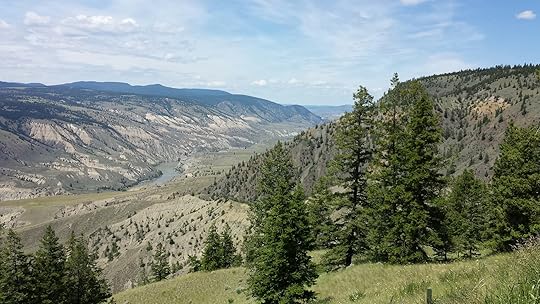 On the Dog Creek Road, driving south from Alkali Lake
On the Dog Creek Road, driving south from Alkali Lake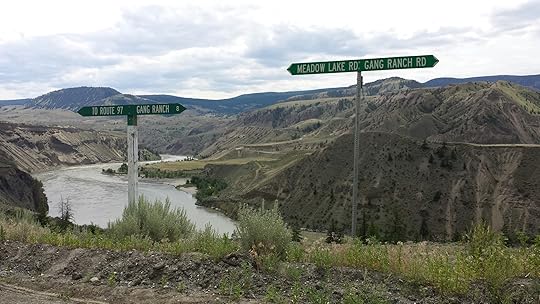 Dog Creek Road junction near Gang Ranch (east side of river)
Dog Creek Road junction near Gang Ranch (east side of river)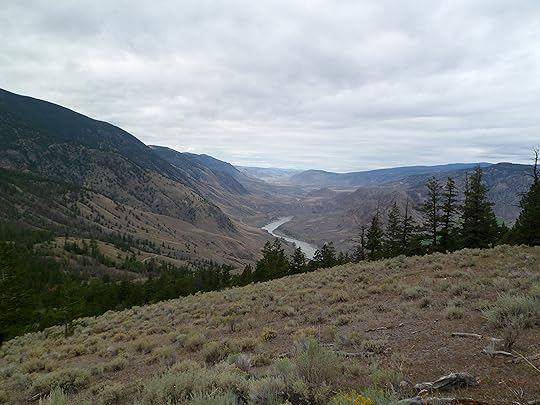 Heading towards Lillooet with Fraser River in distance
Heading towards Lillooet with Fraser River in distance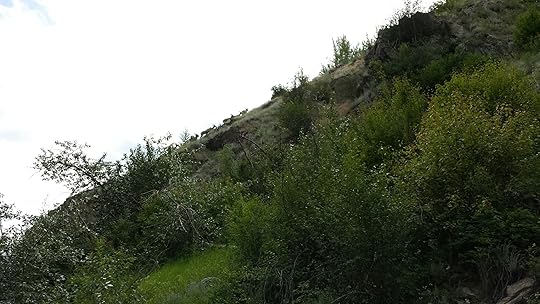 A silhouette of goats heading towards Big Bar on north side
A silhouette of goats heading towards Big Bar on north side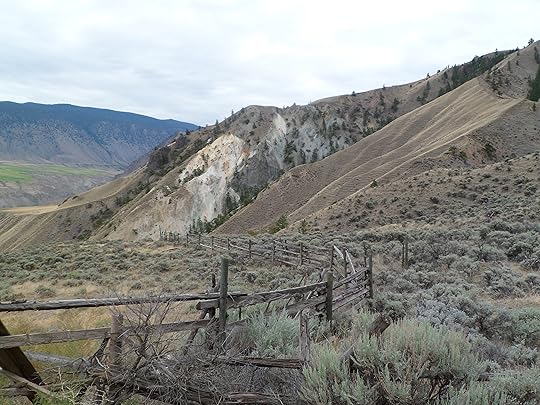 Ranch land and sagebrush near Lillooet
Ranch land and sagebrush near Lillooet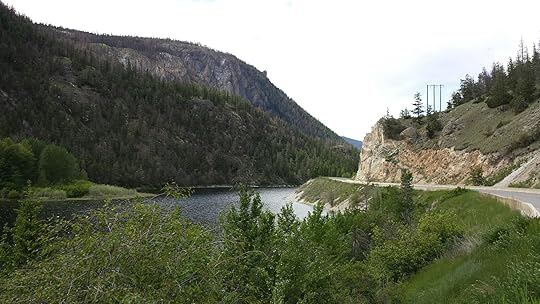 Marble Canyon–Cataline often wintered near here
Marble Canyon–Cataline often wintered near here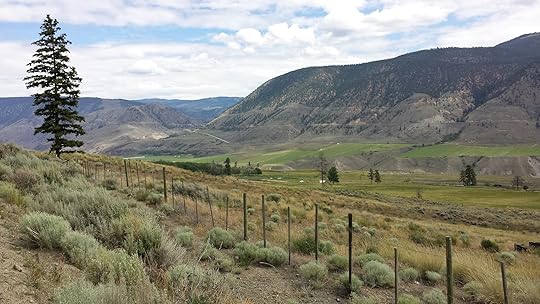 Near Bridge River, close to Lillooet
Near Bridge River, close to Lillooet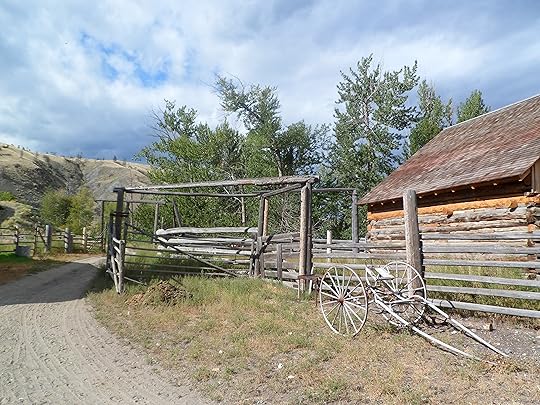 Hat Creek Ranch on a hot day
Hat Creek Ranch on a hot day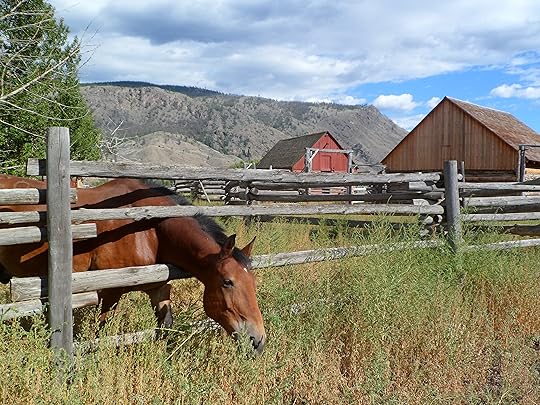 Hat Creek Ranch–Cataline spent time here enjoying drinks with friends
Hat Creek Ranch–Cataline spent time here enjoying drinks with friends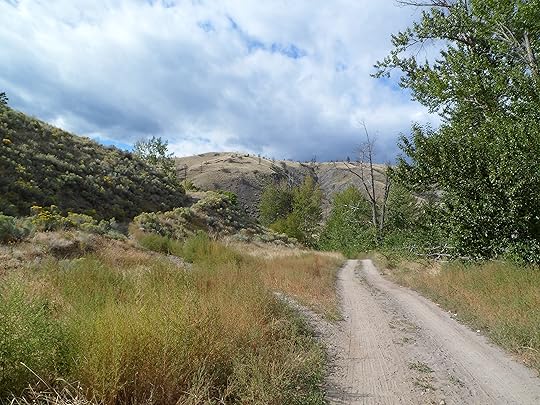 Back on the trail again, heading away from Hat Creek area
Back on the trail again, heading away from Hat Creek areaCataline would have spent time in all of these places as he travelled around the province. Irene Bjerky, whose research gave such a basis to the family background of Jean ‘Cataline’ Caux, and who wrote such a lovely introduction to the book, has compiled lots of information about Cataline’s travel routes on her ‘Packtrails‘ website and I urge you to check it out.
To purchase ‘Cataline: The Life of BC’s Legendary Packer’ go to Caitlin Press’s website, or buy it from your favourite bookseller.
June 3, 2020
Cataline documentary
Sylvie Pelltier of Red Letter Films did a documentary on Cataline a few years ago. It’s a delight to watch, and has has a terrific interview with Irene Bjerky who wrote the introduction to the book “Cataline: The Life of BC’s Legendary Packer” and whose research contributed so much to the background and depth of the book.
If you’d like to check out the documentary “The Legend of Cataline,” here it is:
It is also available in French:
To order a copy of the book, visit Caitlin Press or get it from your favourite local bookstore.



